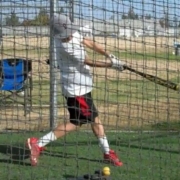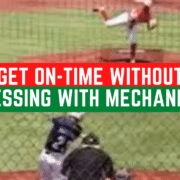We discuss the BEST baseball, fast-pitch softball, and slow-pitch softball batting timing drills. Revealed are our favorite youth beginner rhythm hitting drills and swing tips. We’re based out of Fresno, California.
The Sooner You Know These Batting Timing Drills The Better
Take a guess at one of the biggest hitting frustrations is, according to my readers? Timing! Probably not a shocker because your hitters probably struggle with this as well. Mine do, especially at the start of the season.
This batting timing drills for hitting a baseball and softball video guide will also have information useful to anybody facing the challenge of fixing a hitter with a late swing, getting a kid to swing earlier or sooner, and when to start front foot swing timing.
I always tell my hitters, the most effective mechanics in the world don’t mean a thing, if a hitter CANNOT get “on-time”. In a survey, my readers asked if I use any batting timing drills with my hitters – that work?
Funny, because…
Last week, I was on a call with one of my online lesson dads from Southern California. He said the difference in his son hitting the ball harder, with more consistency, has been because of how we cue one of the batting timing drills I’m about to share with you.
SCIENCE-BASED TRAINING:
Improve your hitting strategy dramatically by applying human movement principles.
Learn not only how and what to train but also the science behind the methods.
Before we get started…
I want you to note that the following two batting timing drills are validated by empirical studies in the science of successful learning. They follow the Principle of Variance (CLICK HERE for a post that explains that).
In this post, I want to share the:
- “Float” Variance Drill, AND
- Reaction Time Variance Drill (aka, the “2-plate” drill).
Watch this Carlos Pena video on how a hitter’s reaction time changes with pitch location…
“Float” Variance Drill
Basically, a “float” is a slight pause before falling forward. Make sure you’re cuing “load slow and early”. This is what helped my SoCal hitter from above. CLICK HERE for this post referencing how Jose Bautista turned his swing around with the same cue.
We want the hitter to pick the stride foot up and shift their weight back. Which means the back knee will have to track over the back toe – and not inside. How far the back knee tracks depends on whether the hitters has a:
- High leg kick,
- Medium leg kick, or
- Slide step/toe tap.
The higher the leg kick, the more the back knee tends to track over the ankle. The knee shifts inside the toe during the fall. And this should be a natural move. It’s difficult for hitters to get “on-time” by just picking up the stride foot and falling forward.
And this is what would happen if the hitter focused solely on keeping the back knee inside the toe pre-stride foot lift. Don’t believe me? Check out this rant post I did on this.
If you still don’t believe me, then do an experiment with the drill, and have your hitters note the difference in their quality of contact and control swinging the bat. This also requires a strengthening of the leg abductors and adductors. Here’s the movement prescription to do that…
Side Band Walks (http://gohpl.com/1G1FlS5)
- Week one: 1 set X 10-yard walk both ways,
- Week two: 1 set X 15-yard walk both ways,
- Week three: 2 sets X 10-yard walk both ways, &
- Week four: 2 sets X 15-yard walk both ways.
Do once daily. Increase band resistance if necessary. Also, the above video demonstrates a semi-leg kick for the drill, this is necessary. The hitter can use any stride tip with the ‘float’. CLICK HERE for a post on different stride types. When to lift the stride foot to start the “float”, will get fleshed out in the next batting timing drill…
Reaction Time Variance Challenge (aka the “2-plate” drill)
In the past, part of my timing training, was to tell my hitters to lift their stride foot at a specified point in the pitcher’s delivery.
Which is okay.
But now, my batting timing drills put more emphasis on trial-by-fire. Let me put my hitter through an environment where they have to learn to calibrate their own timing. I’m trying to melt them down mentally. And they’re trying to keep me from melting them down.
In a game, the same thing happens. To help hitters transfer grooved cage swings into games, we have to train with “random” versus “massed” practice. It has to do with the process of “Read, Plan, Do”.
In other words, this batting timing drill “takes care of business”, in a natural way.
Please post any other batting timing drills – like these – that are working for your hitters in the “Leave a Reply” section below (or share your testing on the drills I included)…










